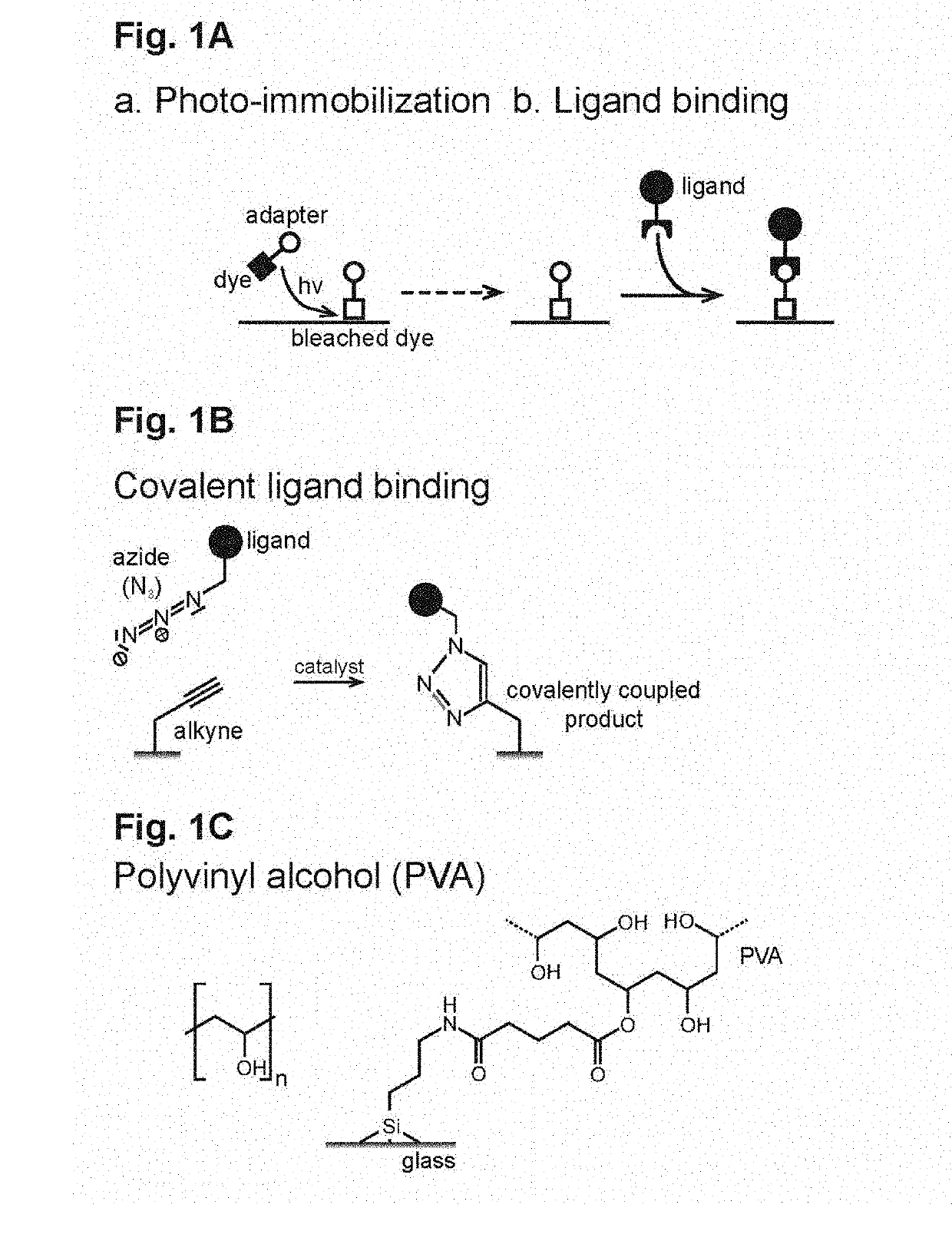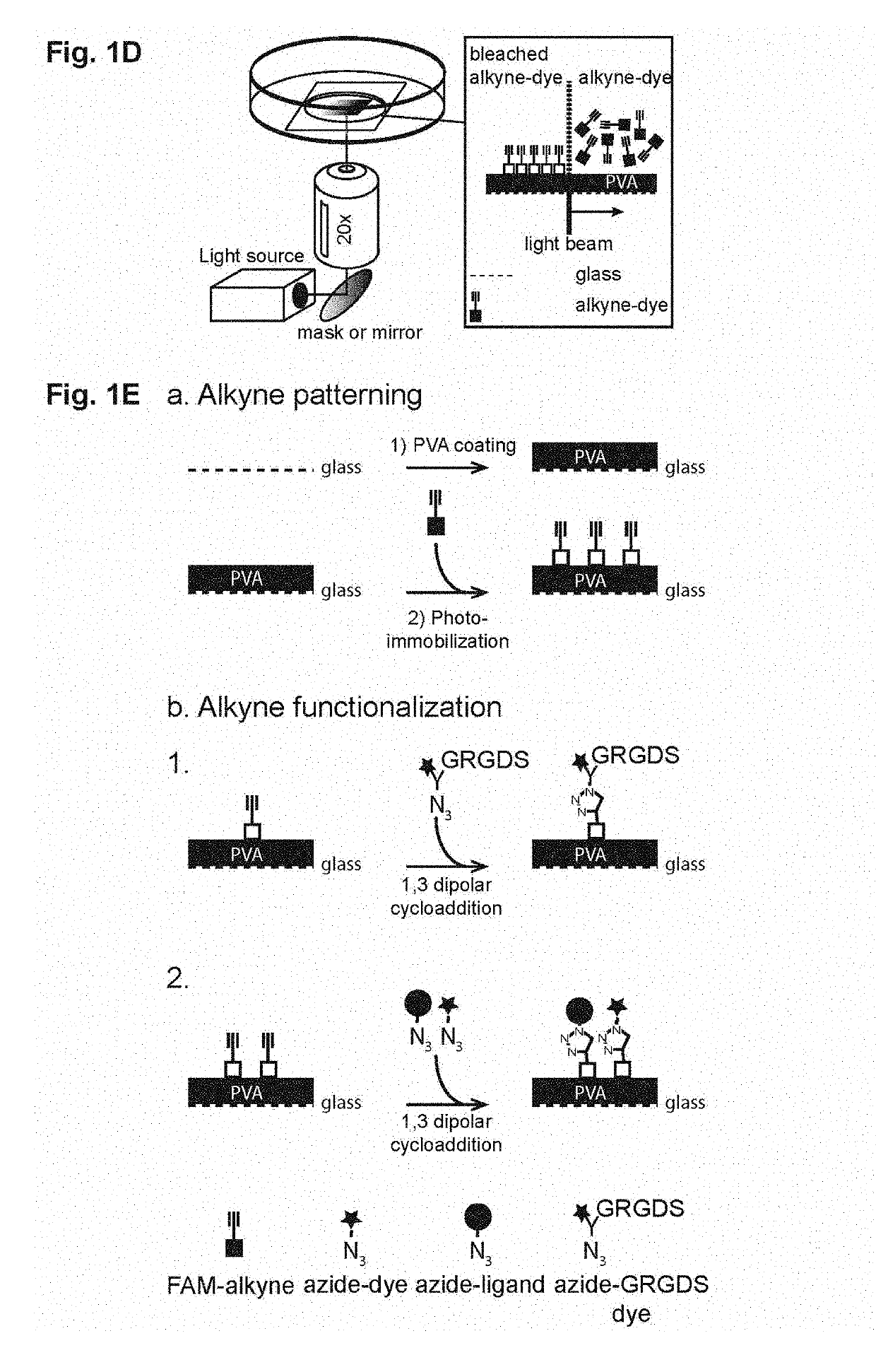Micropatterning assembly, methods for micropatterning, and micropatterned devices
a technology of micropatterning and micropatterning components, applied in the field of micropatterning, can solve the problems of affecting the generation of homogenous gradients, affecting the quality of micropatterning, and affecting the quality of micropatterning, and achieve the effect of flexible and inexpensiv
- Summary
- Abstract
- Description
- Claims
- Application Information
AI Technical Summary
Benefits of technology
Problems solved by technology
Method used
Image
Examples
example 1
ng
[0269]Glass bottom dishes (MaTek, USA) were polyvinyl alcohol (PVA) coated as described earlier (Doyle, 2001). Briefly, the glass surface of a MaTek dishes was activated for 25 min at room temperature with 50% nitric acid (Sigma Aldrich, St. Louis, Mo.). After activation, the dish was rinsed overnight in ddH2O. Subsequently, the glass surface was deprotonated by incubation for 15 min at room temperature with 200 mM NaOH (Sigma Aldrich, St. Louis, Mo.). The deprotonated and washed glass surface (ddH2O) was blow-dried using canned nitrogen. By incubation with 1% aqueous solution of APTES (w / v, Sigma Aldrich, St. Louis, Mo.), the glass surface was amino-silanized for 5 min and carefully washed with ddH2O for 10 min. The amino-silanized glass surface was then cured at 65° C. for 3 h. For aldehyde activation, surfaces were incubated with 0.5% aqueous glutaraldehyde (Sigma Aldrich, St. Louis, Mo.) solution for 30 min at room temperature. A ˜200 nm thick poly-vinyl alcohol (PVA, 6% aqueo...
example 2
obilization of FAM-Alkyne Laser Writing
[0270]Approximately 20 μL FAM-alkyne (6-isomer, Lumiprobe, Hannover, Germany) were placed in the middle of a PVA coated glass dish and patterns were written using a steerable, pulsed UV laser (λ=355 nm) as described before (Weber et al., 2013). Briefly, the UV laser was focused into the interface between the bottom of the PVA coated glass slide and the FAM-alkyne solution with a long working distance 20× objective (Zeiss LD Plan Neo 20×0.4). A pair of high-speed galvanometric mirrors, controlled by a custom program, was moving the focal spot within the FAM-alkyne droplet.
[0271]The gradient pattern was specified by an image whose pixel values determined the light dose used for bleaching. Careful calibration allowed compensating for the off-center drop-off of numerical aperture of the objective as well as the geometric distortions from the imperfect imaging of the scan mirrors into the back aperture of the objective. This allowed gradient writing...
example 3-1 , 3
Example 3-1,3 Dipolar Cycloaddition
[0274]
TABLE 1Click reaction mixture.VolumeComponent2.2 μLClick-it cell reaction buffer (Thermo Fisher Scientific Inc.)19.8 μL ddH2O2.5 μLReaction buffer additive (Thermo Fisher Scientific Inc.)0.5 μLCuSO4 5 μLRGD-HF555 (30 μM)
[0275]GRGDS-HF555-Azide (RGD-HF555) was custom synthesized by Eurogentec (Serain, Belgium). Following laser writing or projector based patterning, the alkyne patterned PVA surfaces were washed with PBS and incubated for 30 min in the dark with the reaction mixture (Table 1). After washing with PBS, RGD-HF555 patterns can be stored for up to a month under PBS.
PUM
| Property | Measurement | Unit |
|---|---|---|
| wavelength | aaaaa | aaaaa |
| wavelength | aaaaa | aaaaa |
| wavelength | aaaaa | aaaaa |
Abstract
Description
Claims
Application Information
 Login to View More
Login to View More - R&D
- Intellectual Property
- Life Sciences
- Materials
- Tech Scout
- Unparalleled Data Quality
- Higher Quality Content
- 60% Fewer Hallucinations
Browse by: Latest US Patents, China's latest patents, Technical Efficacy Thesaurus, Application Domain, Technology Topic, Popular Technical Reports.
© 2025 PatSnap. All rights reserved.Legal|Privacy policy|Modern Slavery Act Transparency Statement|Sitemap|About US| Contact US: help@patsnap.com



